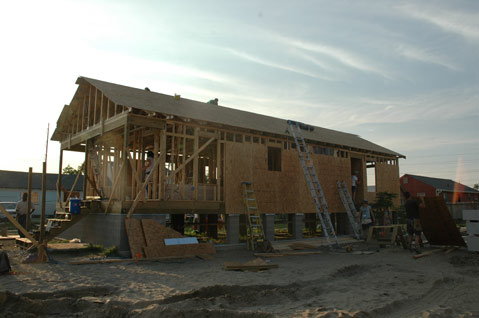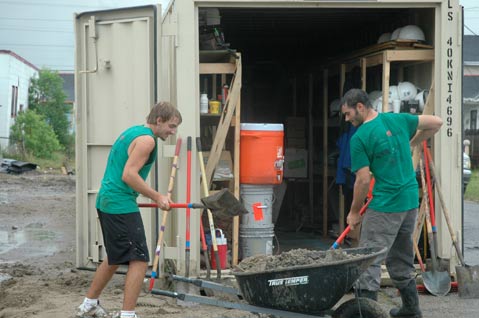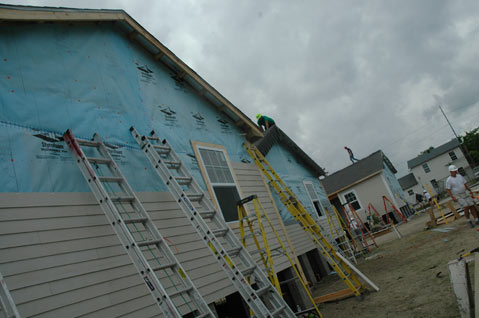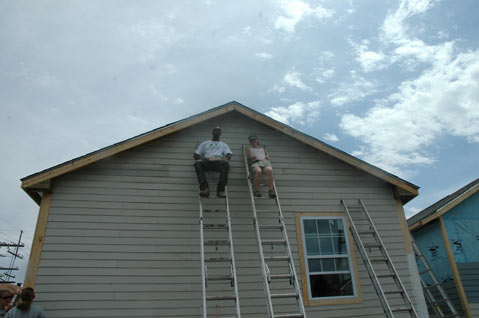Volunteering with Habitat for Humanity in New Orleans
Back to New Orleans

I’d been back to New Orleans since Katrina, for the first post-Katrina JazzFest, the festival that, over a decade’s worth of years, had endeared the city to me. I’d watched from the seats of the tourist-packed JazzFest shuttles, Abita in hand, as people carried armloads of rubble to what were once their porches, easing my conscience by pouring money into the local economy-or at least into the hands of every bartender, waitress, and cabdriver I encountered. Then, eight months after the fact, it looked as though the storm had just happened. The miles of land under Interstate 10 were littered with totaled cars, the water line was visible everywhere. It was heartbreaking. I had to do something. Nearly three years later, I did.
I registered with Habitat for Humanity, utterly unfazed by the fact that I had no experience whatsoever in the home construction arts, and set off in my car, equally unfazed by the mechanic who’d warned, “I certainly hope you don’t plan on taking this car anywhere out of town.”
Two weeks, 4,000 miles, and one speeding ticket later, I arrived, noticing that, this visit, the water line was still around-if a little faded. But those cars were gone, replaced with tents-a village of refugees in their own hometown.

Slowly, I made my way to Camp Hope, cheap, dorm-style housing for volunteers in a building that was once a school, a school with no need to reopen. Farther out of town, deeper into St. Bernard Parish, I noticed fewer businesses open. More parking lots deserted. Fewer people outside, fewer cars on the road. It was, for all practical purposes, a ghost town.
By way of greeting, the AmeriCorps kid manning the front desk gave me a lecture about not bringing food into my room. “We have a really bad fire ant problem,” he said, eyeing me. Signs above the communal shower room broke down how best to use your four minutes of water. As dismal as the shower situation was, the coffee was worse.
Camp Hopers traveled in packs, which made me something of an anomaly. And they skewed young. Overall, the scene was much, I’d imagine, like Band Camp. Regardless, a couple other solo women-of-a-certain-age and I found each other and made plans to carpool.
The next morning found us pounding the aforementioned bad coffee, packing lunches, and piling into a car, directions to Musician’s Village in the Upper Ninth Ward in hand. We arrived and were assigned a home a short drive away. Laying the sod was our first assignment, and while we cleared ground and then the pallet, the homeowners and their three dogs emerged from their trailer.
At first take, Joy and Charles were people of few words. But somewhere between laying that sod, hanging the closet doors, and installing the trim in the bathroom, they got to talking. Taking a break one afternoon, I sat with Joy and a friend of hers who’d happened by. Joy’s friend was trying to point out how lucky they were; Joy was having none of it. “Yes, I’m angry,” she said in that rich, slow, deliberate N’aaawlins accent. “This was no act of god, this was man.”
Joy and Charles were 11 months from paying off their original mortgage when Katrina hit, when the levees broke. They’d been living in the FEMA trailer ever since, working their jobs, while also trying to log the 350 hours “sweat equity” required by Habitat vis- -vis downpayment.
“If we can survive this, we can survive anything,” Charles said one morning. Then he clarified: “I mean living together in that trailer.” He was right-that trailer was damn small.

Across the street was a vast, largely empty lot populated only with the odd pile of rubble. “That was the St. Bernard Projects,” Charles said. Projects so gritty, he said, police and firefighters refused to go inside. He was glad they would not be rebuilt, didn’t think much of the protestors objecting to that decision; this was his neighborhood, after all. Nearby, he pointed out his church-he belonged to the choir, and had performed in the Gospel Tent at many a JazzFest. The diocese had just announced it would not reopen. About this, though, there wasn’t a peep of protest.
That Friday afternoon, as we inventoried tools for the next week’s blitz build, Joy gave each of us a necklace, from the few of her possessions that had made it through the hurricane.
Meanwhile, back at Camp, a fresh crop of volunteers was flooding in, ready to take on the enormous challenge of the following week: completing seven homes, start-to-finish, in five days, and framing an additional 20, as part of the 2008 Jimmy & Rosalynn Carter Work Project. Monday morning went by in a blur, and my services as a driver were requested by some people I’d met over the weekend, when, after an ill-advised run through the muggiest air conceivable, I discovered the showers were closed for cleaning and was duly forced to “shower” under the garden hose (and in front of an audience). We piled in, and set off to Odile Davis Park, rendezvous point for the week.
Once assembled, my group paraded to our site, where we found a raised foundation, a whole lot of lumber, and a dreadlocked leader who was not fooling around. Grab a hammer, he said, let’s raise these walls. They went up quickly, and before I knew it (and before lunch), I was on a ladder in the backyard, one of three foolish (or, you know, brave) souls who’d volunteered to lift the trusses onto the top of those walls. Though they seemed to grow steadily heavier, my heart was pumping, and I had no intentions of letting anyone else finish the job.
The hours flew by; the frame flew up. We heard music, and turned to see some kids marching up the street, led by a young girl twirling a baton. I was getting the hang of how to swing a hammer, and reinventing myself as a yes-woman. Albeit a lying one. “Are you okay on ladders?” “Yes.” “Are you comfortable on the saw?” “Yes.” “Do you want to help out on the roof?” “Yes.”

I was regularly terrified: installing rat runs in the rafters, wobbling on what would become the beams of the attic while carrying 2x4s, a hammer, tape measure, and nails. I was uncomfortable: contorting atop an A-frame ladder so I could reach to install insulation, teetering atop an extension ladder, attempting to get a nail into the final piece of siding beneath the home’s back eave (and smashing my thumb and first finger in painful, rapid succession in the process). I was totally out of my element: dropping the occasional hammer off the roof, the occasional gob of caulk onto my shoes. I stunk, I ached, I was filthy. I felt incredible.
“You’re fearless,” said Debbie, a volunteer with the world’s most beautiful lotus tattoo on her arm, as I stepped down from the roof to hit up the ice cream man who’d discovered this gold mine of a street, teeming as it did with hot, hungry workers. I looked behind me, to see who she was talking to. There was no one there.
She couldn’t possibly be talking to me, I thought. But she was. And then I realized, I was in my element.
The final two days were a sprint, and the weather was unsympathetic. Thursday morning thunderstorms meant a sticky, muddy, caulk- and sawdust-covered circus as 20 of us raced to get interior detail work finished before the carpet arrived. The skies cleared by afternoon, and, as the puddles steamed away to nothing, the air became thick with humidity and bugs. The front gable needed painting; I volunteered, and worked atop an extension ladder poised on one of the front steps, supported by two nails, until the sun went down.
Friday morning was met with thunder, lightning, rain. Laying the sod was the final task, but first, we had to locate the sidewalk. Sidewalk? We dug, mud flew, and finally, about two feet down, we hit it. And when, that afternoon at the dedication, Vicki, our homeowner, was handed her keys on the front steps of her new home under blue skies, it wasn’t pride behind my smile, just happiness.
And hope.
4•1•1
Portions of this story are excerpts from the author’s essay, “Something Worth Saving,” from the forthcoming anthology Submerged: Tales from the Basin, a portion of the proceeds from which will help support charities based in New Orleans that work with ongoing relief efforts for Hurricane Katrina survivors. For information, check out StepSisterPress.com/Submerged.html. For information about Habitat for Humanity, visit habitat.org; for info about the Santa Barbara area affiliate, visit sbhabitat.org.
Reduce, Reuse, ReStore
On Saturday, August 23, our local Habitat for Humanity affiliate will celebrate the grand opening of a ReStore, a retail discount home improvement center where used, salvaged, and surplus materials are sold below retail prices and 100 percent of the revenue from all sales goes directly back to Habitat. There are more than 200 Habitat ReStores nationwide, which ultimately allow their local organizations to fund the construction of new Habitat homes in the area. ReStores rely on donations of usable building materials including lumber, cabinetry, plumbing fixtures, windows, doors, and other architectural salvage, thereby reducing landfill waste and recycling these materials for future use. Habitat also uses the materials in the construction of new home building projects: On Habitat’s last area building project, Via Lucero, over 15 percent of the materials came from materials donated to the ReStore.
4•1•1
The ReStore’s grand opening takes place Sat., Aug. 23, at 6725 Hollister Ave. in Goleta from 9am-2pm. There will be demonstrations by licensed contractors, as well as hourly drawings. ReStore will be open Thursdays, 1-4pm, Saturdays, 9am-1pm, and by appointment. For more information, call 692-2226 or visit sbrestore.org.



